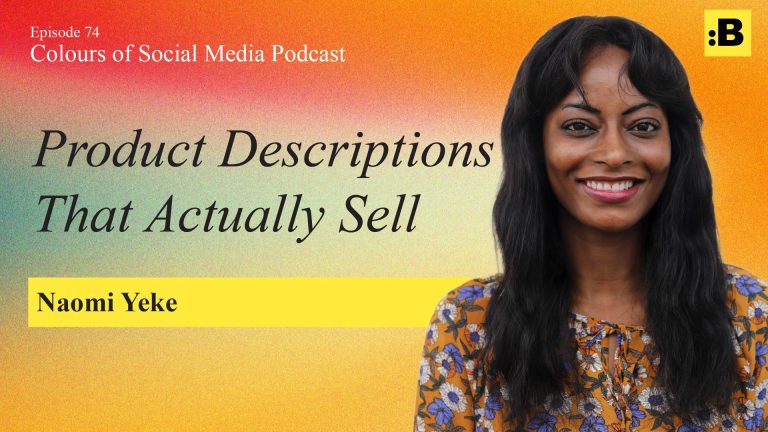|
Getting your Trinity Audio player ready...
|
Are Your Product Descriptions Selling or Silently Sabotaging Your Sales?
I had the pleasure and honour of welcoming Naomi Yeke, a product marketer and PR and comms specialist, for her podcast debut. As a copywriter by background, Naomi’s passion is to “propel brands by translating what they do or what they offer into messages that resonate with their target audience.” She’s a big believer in clarity and a messaging strategy that inspires action. Her insights come from seeing great brands falter because their messaging didn’t land, like the recent Jaguar rebrand which, despite being colourful and modern, “didn’t really resonate with their audience at all”. It’s a stark reminder that if we’re not writing for our customers, “then who are we writing for?”
Features vs. Benefits: A Crucial Distinction
One of the biggest eye-openers for many, including me, is the fundamental difference between features and benefits. On e-commerce sites, you often see descriptions listing both.
-
A feature is “basically what the product itself does”. Think “10 GB of space available” for a cloud product.
-
A benefit, however, is “what the customer or the end user gets from the product”. So, instead of just 10 GB, a benefit would be “enough space to save every memory”.
Naomi’s powerful advice is to always lead with the benefits when speaking to customers. Features provide context, yes, but concentrating energy on what the person is getting from the product personalises the message and creates a connection. This resonates deeply with my own experience in paid advertisements; leading with addressing a customer’s pain points has consistently led to good conversion numbers for me. It makes sense – you’re talking directly to the customer.
Common Product Description Blunders to Avoid
Even seasoned marketers, myself included, can fall into these traps. Naomi highlighted several mistakes that can quietly hold your product descriptions back:
-
Too Much Jargon: Using industry-specific or overly technical terms can alienate your audience.
-
Vague Messaging: If your message isn’t clear or doesn’t directly speak to the product’s value, it won’t land.
-
Being Overly Verbose: Trying to sound intelligent with too many words or complex sentences can actually obscure your message.
The takeaway? “Just use simple language”. Always consider your audience. While developers might understand “API documentation,” the “everyday person” needs simple terms. Don’t say “press the hamburger app” if your audience won’t get it.
Low-Hanging Tweaks for Higher Conversions
Naomi shared some actionable “low-hanging tweaks” that can significantly improve your product descriptions:
-
Simple Language: Simplify complex terms in your production descriptions. Instead of “water-resistant,” try “you can swim with this”. It’s the same message but resonates differently and makes it more accessible than “IP 60”.
-
Break Up Your Copy: Avoid “one big exact paragraph”. Use one-liners, bullet points, and bolding to make the text dynamic and easier to digest.
-
Benefits First: Reiterate that the primary emphasis should always be on the benefits. This is even something that Google’s AI mode is apparently crawling for on websites now.
For a structured approach, Naomi recommends the FAB (Feature, Advantage, Benefit) framework. This ensures a “very rounded message,” where customers understand the feature, its advantage, and how it translates into a personal benefit for them.
AI: A Tool, Not a Replacement
The conversation naturally turned to AI and its role in copywriting. Naomi made it clear: AI is a tool, not a replacement. She cited research showing that while AI-generated copies are “decent,” human-edited AI copies perform significantly better, converting people at a rate 23% higher than raw AI outputs.
Marketers can use AI to:
-
Refine messaging.
-
Generate variety in copies (different tones and formats for various platforms).
-
Speed up content creation.
However, the human touch remains irreplaceable. AI lacks context, nuance, and cultural sensitivity. I recall a campaign where ChatGPT coughed out some names for people in an African country, which a local later informed us were actually derogatory terms!. AI wouldn’t understand that. As Naomi puts it, “There has to be some intentionality behind what you do” when building relationships with customers.

The Ultimate Priority: Clarity
Naomi’s strongest advice, and something I wholeheartedly agree with, is to prioritise clarity in all your copies and messaging. It might seem like a small thing, but it’s “that small win that can change everything for you”. She shared an example of Jumia in African markets, where early product listings had poor, sometimes even copied, descriptions. Despite heavy traffic from digital ads, customers weren’t happy. But over time, they cleaned up their pages, making descriptions “more well written, more well presented,” and it became “one of their optimization like levers”.
By focusing on benefits, simplifying language, structuring copy effectively, and using AI judiciously while always adding that crucial human element, you can craft product descriptions that truly resonate and drive conversions.
To get all the insights from Naomi Yeke, listen to the full episode of the Colours of Social Media Podcast wherever you get your podcasts! You can also connect with Naomi on LinkedIn by searching for Naomi Yeke (N A O M I Y E K E ) and explore her Medium publication for more of her thoughts on marketing and copywriting.


